When everyone makes a crossover SUV, how do you make your crossover SUV stand out?
First, you split the difference between compact-sized crossovers like the Mazda CX-3 and mid-sized crossovers like the Honda CR-V.
You give it a roomy back seat – and a roomy cargo area – but a small overall footprint.
Next, make all-wheel-drive standard. It’s generally optional – and costs extra – in other-brand crossovers.
Then give it class-leading ground clearance – almost 9 inches – and make the standard AWD system more capable and performance-oriented than rivals’ available, but less-capable, systems. 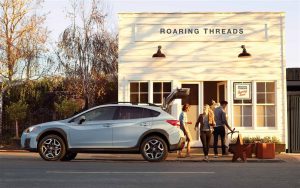
Give it a low center of of gravity – by fitting it with a flat four engine that’s hunkered down in the chassis – so it’s not tipsy in the curves, despite being able to ford creeks and handle serious snow.
Offer all that with a manual transmission – something that’s becoming as rare in crossovers as smoking lounges at airports.
Result?
A crossover that’s not just another one.
WHAT IT IS
The Crosstrek is Subaru’s entry-level crossover SUV. 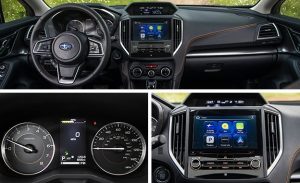
It effectively takes the place of the Outback wagon (which is full-sized now and also at the top of Subaru’s price roster) as the company’s most affordable back-road Banzai-mobile.
It is larger – and roomier inside than most of its compact-sized competition, including models like the Mazda CX-3. Especially in the second row and behind the second row.
And it offers much more capability than comparably roomy compacts like the Honda HR-V, which has much less ground clearance (6.1 inches) and an optional AWD system that’s not as capable as the Soobie’s – and which isn’t available with a manual transmission.
Crosstrek’s prices start at $21,795 for a base 2.0 trim with AWD and six-speed manual transmission.
A top-of-the-line Limited trim with AWD and continuously variable (CVT) automatic stickers for $26,295.
WHAT’S NEW
The 2018 Crosstrek is new from the wheels up.
In addition to an updated exterior/interior – and increased passenger room and cargo space – the underlying chassis/suspension are new and the 2.0 liter engine makes more power – and sooner – than it used to. The manual transmission is a six speed manual now (a five-speed was available last year) and the high-performance torque-vectoring version of Subaru’s highly-regarded AWD system that was first offered in the WRX (and STi) is now standard equipment in the Crosstrek.
Unlike most AWD systems – which kick power front-to-back only – the Subaru system can modulate power delivery side-to-side. This helps balance the Crosstrek during high-speed cornering on dry pavement as well as enhance grip in the wet and snow.
It’s the only crossover in this class that offers a manual transmission and AWD together.
And the manual isn’t limited to the base trim, either.
It’s got more ground clearance than any crossover in this class.
It’s the only crossover SUV in any class that has a flat engine – which serves as a counterbalance to the jacked-up ride height.
It’s priced about the same as smaller or less-capable crossovers like the CX-3 and HR-V.
WHAT’S NOT SO GOOD
Not as much fun to drive (or as good-looking) as the sexy little Mazda CX-3.
Not as space-efficient as the Honda HR-V.
Not as quick as either of those two; both the Mazda and the Honda get to 60 sooner.
In the case of the Mazda, much sooner.
The Crosstrek’s got a 2.0 liter engine – which seems to be the universal engine. Scan the specs of various makes and models and you will find 2.0 liter engines abound.
Do they all come from the same factory?
No. But that displacement is becoming universal – or so it seems – because any larger and the car company gets socked with Save the Planet (C02) fines in Europe, which is a big market for most car companies and also in a round-about way here, too – because any larger and the Feds sock the car company with “gas guzzler” fines.
But any smaller and you begin to have issues with power – which becomes a problem for the people interested in buying the car. This is why almost all the sub-2.0-liter engines on the market have turbochargers bolted to them. Many of the 2.0 liter engines, too.
The Subaru’s 2.0 liter does not have a turbo bolted to it. And it is unlike any of the other 2.0 liter fours on the market because it is a flat 2.0 liter four. All of the others are upright – and in-line fours.
The Subaru’s four cylinders are divided into pairs, with each pair facing the opposite pair across the crankshaft, which serves as the center-line. The opposing pistons within the cylinders “box” one another across the crankshaft – as contrasted with the in-line four’s pistons, which go up and down.
Several advantages to the boxer layout:
One, it’s lighter, because the “boxing” pistons balance naturally – without the need for a heavy external balancer (or crank counterweights) which in-line engines usually have to have.
Two, the weight of the engine is not only lower in the chassis – because it’s flat as opposed to standing upright – it’s also spread out evenly across the centerline of the chassis. Hence “symmetrical.” It is also why Subaru vehicles don’t feel as tipsy as vehicles with similar ground clearance – but with in-line engines and a higher-up center of gravity.
The ’18 Crosstrek’s 2.0 liter four is the same size as the ’17 Crosstrek’s, but it’s been fitted with direct injection (vs. port fuel injection last year) and is slightly stronger now: 152 hp at 6,000 RPM and 145 ft.-lbs. of torque at 4,000 RPM.
Last year’s version of the 2.0 liter engine made 148 hp at 6,200 RPM and 145 ft.-lbs. of torque at 4,200 RPM.
Also new, as mentioned earlier, is the standard six-speed manual transmission; it replaces the previous five-speed box. A continuously variable (CVT) automatic is optional and if you buy it, you’ll also get driver-selectable X-Mode with Hill Descent Control, to keep the Crosstrek from building excessive speed when going down a slick road. The CVT transmission also comes with a driver-selectable manual mode and steering wheel-mounted paddle shifters.
Gas mileage is up – slightly – to 27 city, 33 highway with the CVT. With the manual, mileage dips slightly to 23 city, 29 highway. Part of this dip may be due to the manual version’s more aggressive final drive ratio – 4.4:1 vs. 3.90 for the CVT-equipped Crosstrek.
The manual version is also quicker for this reason – low-mid nines to 60 vs. mid-high nines for the CVT version.
Both versions are not as quick as rivals like the Honda HR-V (which is only slightly quicker; zero to 60 in the low nines) and the Mazda CX-3 (which is noticeably quicker; zero to 60 in about 8 seconds flat).
But, the Crosstrek comes standard with AWD. It’s optional in the Mazda and the Honda.
And it’s not just AWD.
The Crosstrek’s torque-vectoring AWD works with the ABS system to balance out the car by applying braking pressure to the inside wheel(s) during high-speed cornering. Similar systems are available in high-end/luxury crossovers like the Acura MDX but none of the Crosstrek’s price-comparable rivals offer anything like it.
ON THE ROAD
The Outback acquired a loyal fan base because it was both capable and fun. Also inexpensive. And not too big.
Because the current Outback is based on the Legacy – Subaru’s top-of-the-line and full-sized sedan – rather than the Impreza – Subaru’s entry-level compact sedan.
The Crosstrek’s foundations are – or were – Impreza. The new one rides on Subaru’s Global Platform, which will likely underpin the next-gen Impreza as well.
Either way, the Crosstrek is still Impreza-like in that it’s not too big – and not too small. You will find that it’s easier to maneuver it in busy parking lots than mid-sized crossovers like the Honda CR-V and Toyota RAV4 because of its more compact dimensions (more on this below) but it doesn’t feel as compact as the HR-V.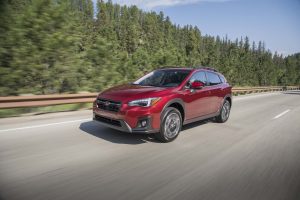
And while it’s not as quick as the peppiest-in-the-segment CX-3, the combination of a growly boxer engine, a manual transmission and that notch-above torque vectoring AWD system make it more fun to drive than you might expect – kind of like the girl you ask on a date who isn’t cheerleader material, maybe – but finds ways to make up for that.
The CVT isn’t bad, either.
In fact, it’s pretty good.
You lose a step as far as quickness, but this box is not a noise machine – as some are. To be fair, this problem is usually the result of not enough engine, rather than the CVT itself. These boxes are designed to get the engine into the sweet spot of the powerband – where the engine makes the most power – as quickly as possible and hold the engine there, to maximize acceleration when the driver needs it. But if the engine doesn’t make much power, it feels (and sounds) as though the engine is screaming, which it is.
The Crosstrek’s four isn’t a powerhouse – but there is enough power to work well with the CVT.
The manual, though, makes the Crosstrek more fun.
The main thing, though, is that the Crosstrek is without doubt the most rugged individual in its peer group. You can take it places – like my back field, for instance – that you’d have to be high to attempt in the CX-3 or the HRV, neither of which have the clearance to deal with what’s out there.
That extra measure of capability is the real draw here. I dig the CX-3; it can take corners like a Mazda3 (which is the sport sedan it’s based on). But it can’t take snow – or off-road – like the Crosstrek.
Neither can the HR-V, space-efficient as it is.
More on this part now.
The ’18 Crosstrek is marginally shorter overall than last-year’s model – 175.8 inches vs. 175.9 inches – but it rides on a slightly longer wheelbase: 104.9 inches now vs. 103.7 inches. This pushing out of the front and rear axle centerlines made it possible to carve out a bit more room inside.
Especially in the second row.
The backseaters now have 36.5 inches of legroom vs. 35.4 inches before – a gain of more than an inch, which is a noticeable difference.
Cargo space behind the second row is a bit less than before – 20.8 cubic feet vs. 22.3 cubic feet before – but total cargo space (second row folded down) increases to 55.3 cubic feet vs. 51.9 cubic feet previously.
This is a much more balanced use of the available space inside than the gorgeous-looking but much less practical Mazda CX-3, which only has 12.4 cubic feet of cargo space behind its second row (44.5 cubic feet with the second row folded down).
The Honda HR-V is without doubt the most space efficient of the bunch, though. It has an incredible 39.3 inches of second-row legroom and 24.3 cubic feet of cargo space behind the second row and 57.6 cubic feet of total cargo capacity with the second row folded – notwithstanding it’s only 169.1 inches long overall – almost seven inches shorter overall than the Crosstrek.
But, the Honda – like the Mazda – has to put it in Park at the edge of the field – or the edge of the creek – and watch as the Crosstrek goes about its business.
THE REST
It’s unusual to find that you can get a manual transmission in more than just the base trim; this means you don’t have to choose between the manual (assuming you prefer that) and the nicer trim/optional stuff you can get in higher trims. Subaru lets you have the manual in both the base 2.0i trim and the Premium trim – which gets you leather, heated seats and the option to buy Subaru’s suit of EyeSight safety technology, which includes rear traffic alert ad a blind spot monitor. It’s called EyeSight, incidentally, because the camera system is mounted up high – at eyesight level. It’s part of the rearview mirror assembly.
This, too, is a uniquely Subaru feature.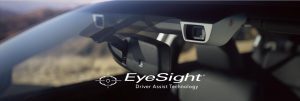
Another thing about the Crosstrek is that it’s got a larger-than-most gas tank: 16.6 gallons. The Mazda CX-3’s tank holds just 12.7 gallons. That makes the Mazda seem a lit thirstier than it actually is, because even though it rates 27 city, 32 highway – effectively the same mileage as the Crosstrek – you have to stop to fill up more often because the thing carries almost 4 gallons less fuel.
If you are averaging say 30 MPG, that means the Subaru can go about 120 miles farther before you have to stop for gas.
Similar issue with the Honda HR-V. Its gas tank is also small – just 13.2 gallons.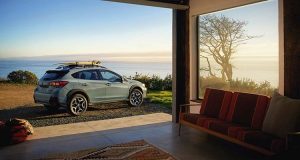
It’s odd that both Honda and Mazda would choose to fit their fuel-efficient crossovers with tanks so small it makes them seem a lot gas-hungrier than they are.
THE BOTTOM LINE
If you miss the old Outback, you will like the new Crosstrek.
And if you like the CX-3 and HR-V but need more balance – or capability – you will want the new Crosstrek.
. . .
Got a question about cars – or anything else? Click on the “ask Eric” link and send ’em in!
If you like what you’ve found here, please consider supporting EPautos.
We depend on you to keep the wheels turning!
Our donate button is here.
If you prefer not to use PayPal, our mailing address is:
EPautos
721 Hummingbird Lane SE
Copper Hill, VA 24079
PS: EPautos stickers are free to those who send in $20 or more to support the site. Also, the eBook – free! – is available. Click here. Just enter you email in the box on the top of the main page and we’ll email you a copy instantly!


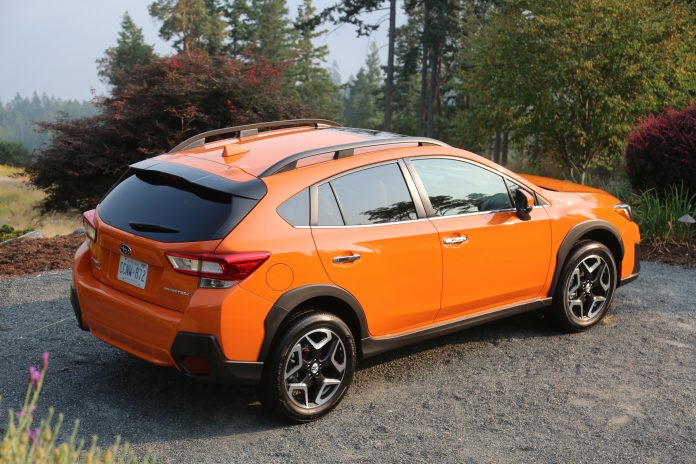

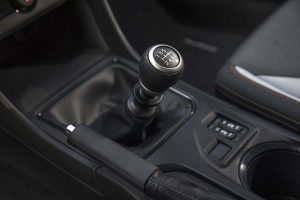
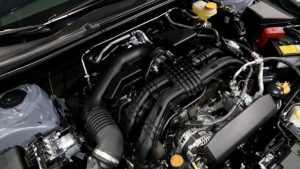
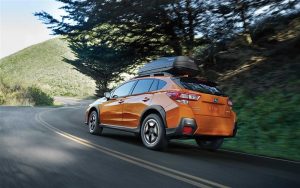
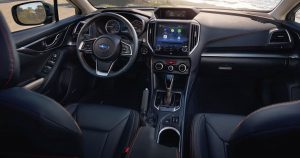








These wagons have gotten a younger, wilder version of this grown adult through many a frozen winter/cold summer up north of the frozen tundra. The AWD is simply incredible in the deep white stuff, frozen lakes, snowmobile trails, you name it. The economy & space were huge selling points too.
However, after dropping $5,000 on two of them (wife & I), & having numerous family, friends, & relatives do the same, I’m sure I’d never own another. We were all very practical about our maintenance, & did fluid changes in advance of any of the recommended intervals.
The headgaskets were the culprit on all these models, from late 90’s through mid-late 2000’s. The purported benefits of said engine are quickly negated when one has to PULL THE DAMN THING OUT to R&R the heads/gaskets/water pump/timing belt due to overheating brought on by their faulty head gasket material. On 1 particular vehicle this job had to be repeated because the wrench skipped replacing a $100 tensioner, which subsequently failed, throwing the valves into the cylinders on this interference engine. The second mech. was able to sneak the head back on the vehicle with the new gasket in place after replacing valves/etc. But this technique is FAR from reccommended.
Fun=yes.
Expensive=yes!
Eric, gents here is alink showing a lift kit being installed. This seals it for me I’m ordering one to replace my 2003 tahoe Z71(getting up in age).
OOPS 😉 https://www.youtube.com/watch?v=IwpqkK64z80
Going to dealer tomorrow to drive and work out a build. BTW you can’t get manual WITH eyesight and leather. Only the rubberband CVT, ugh!
“Subaru lets you have the manual in both the base 2.0i trim and the Premium trim – which gets you leather, heated seats and the option to buy Subaru’s suit of EyeSight safety technology”
From my research Premium trim w/ manual transmission can’t add any packages.
EyeSight, etc. packages appear only to be available with the CVT.
Might as well stick with the manual in base trim and add the fog lights yourself for a couple hundred bucks.
And does switching to direct injection mean carbon fouling problems down the line?
Or will a fuel additive w/ PEA keep it clean?
(asks the owner of a 1997 Legacy w/ 195,000 miles)
it appears only base and midlevel allow you to have leather/eyesight AND manual. I’m talking to dealer about ordering one myself thanks to Eric’s review.
Eric,
Do you know anything about the factory tires? My 2012 Outback came with top of the line all season. My 2016, to my later chagrin, came with midtier all season. Bottom line, the lower quality factory tires have negated other handling capability improvements. I’m too cheap to switch in winter; it cancels out why I go with Subaru, in some ways.
Run Nokian WR G3s and be done. I have these all weather tires on both of my Volvos. They have been excellent in all conditions that I’ve so far. My only complaint is that they squeal a bit more when pushed hard than the OEM Pirellli Scorpions the car came with.
Did you make any money, get a credit for turning in the OEMs?
No because they had just about 40k miles on them. They were worn to the point where another winter on them would be sketchy.
Thank you. Next time, I am going to try to negotiate tires upfront.
That might work depending on what tires the dealer has in stock and how bad they want the sale. I’ve been helping several individuals in the car buying process recently and I’ve noticed that dealers in northern Colorado have really been emboldened by the increased demand caused by the Texas floods. Most dealers are sticking to their guns at 3 to 5k over KBB dealer price. It’s an extremely interesting and honestly quite annoying situation. Usually it’s not difficult to get a car from a dealer for around the private party price.
Looks like the AVO turbo kit can run 220 WHP and 227 TQ with an 2.5 in exhaust. Not too bad. That should put it on par or just beyond with the 2017 WRX output. https://youtu.be/i8wMbyeM93k
re this: “It’s odd that both Honda and Mazda would choose to fit their fuel-efficient crossovers with tanks so small it makes them seem a lot gas-hungrier than they are.”
Tradeoffs. A bigger tank will be slightly heavier, and take up volume that might be used to make the interior more space efficient, like the Honda. And, those extra 4 gallons or so of gas make the Subie effectively heavier and thus slower accelerating when you first fill it up.
The question thus is whether, for the mix of buyers of a vehicle, the marginal advantage of a lot more range and slightly less time spent refueling over the life of the car is worth the tradeoffs above. If you’re mainly just putzing around in the city, probably not. If you’re out on a road trip where gas stations are few and far between, especially out in the sparsely settled West, that extra range is mighty handy.
I’d definitely prefer the range. You could always keep the tank partially filled for tooling around town or in the mountains then fill up for road trips. The tank in my tC is pretty small so I end up having to refill quite a bit during road trips. The tanks in my Volvos are quite large which helps in the city when fuel economy isn’t really that great and on road trips when economy goes up to around 26 MPG. I’ve been able to go from Las Vegas, NM to Cheyenne, WY on one tank (with range to spare) in 3 different Volvos (one 2001 and two 2014s). Can’t quite do that in the tC with its smaller tank.
A most practical choice for frugal buyers who want a transportation appliance with slick road and moderate off road capacity.
Makes a lot of sense……..and boring as hell.
But I do like that snazzy orange paint job. 🙂
Hi Mike,
I wish I could get away with taking video of my running this thing (and others) full tilt “up the mountain.” Then you’d come ot know it’s actually not boring as hell! 🙂
Makes it easy to find in the parking field at the Mega-mall.Hope it doesn’t have the head gasket problems of some of the older Boxers, the older Subarus were favorites of the local”Model Garage ” ( mainly because people never serviced the cooling systems)
On the subject of cooling systems, most cooling systems don’t get serviced because there is such a production made of doing it.
I would never buy a Subaru again. Although they look pretty solid and have a solid drivetrain, I had nothing but problems my 2010 Legacy. I had on going problems with noisy suspension. I had to replace a CVT transmission solenoid body, wheel hubs going bad, alternator,, constantly breaking wheel studs, and an AC compressor bearing that was ready to go out (I would of course have to replace the entire unit). It will be a cold day somewhere when I darken the door of another Subaru dealer. I hated the way the thing sounded with the CVT and until I replaced the FSB with a 26 mm unit, thought the handling was on par with a 71 Impala.
The newer ones are marginally better, but the CVT is still there and still sucks. The new ones are also saddled with more electronics than Best Buy. I’ll pass.
Hi Swamp,
Personally – I hate CVTs. I have driven countless examples and – my opinion – they are all grossly inferior to a conventional automatic or manual transmission. They are noisy and surgy and feel … weird. They lack the torque multiplication feature you get with a conventional automatic and the fun you get with a manual.
All you get is a maybe 3 or so MPG uptick, which – to me – isn’t worth it.
Yeah, I guess so. For me, the performance of the car is a huge selling point. If it can hit 60 in under 6 seconds (like my XC60 does), I’m willing to pay a premium for reasonable expenses down the road. In the past, BMW, Mercedes, Audi, and Jaguar have been too high a price to pay for what they give you and how much the vehicle will cost to maintain. As a result, I have avoided these brands like the plague. I think Subaru could probably get the performance to reliability ratio right. In that vein, I’d actually prefer the output of the WRX in a Crosstrek body and I actually think a lot of buyers would agree. I actually looked at the STi a few years ago when the new body style came out but the loss of the hatchback killed the sale for me and I went with a new XC60 (having come from an XC70). Word on the street is that Subaru won’t turbocharge the Crosstrek because they believe that it will siphon sales from other models. In my mind, not offering the Crosstrek with the WRX/XT engine is costing them sales via people moving on to other cars that offer the power with a hatchback. AFAIC, a turbo Crosstrek could take the place of the WRX or STi Hatchback.
Hi AMS,
My understanding is the same; Subaru doesn’t want to bleed off sales from the WRX or the Forester. On the other hand, one of the big appeals of the Crosstrek is its very reasonable price. It’s so reasonable, in fact, that you could put the money you saved toward a turbo kit – bet you could do it for about $3k, parts and labor. I’d keep the boost fairly low, just enough to kick the power up to around 210 or so.
I wish I had the resources do stuff like this and Report!
Eric,
It’s funny that I was thinking the same thing when I was reading your article. The only problem I can see is that it would void the warranty. I may give this model a few years and maybe if I can get one used at a good price, I may try to turbo one for grins. The problem with my area (northern Colorado/southern Wyoming) is that these Subies have insane resale value. I might have to go out of state to get a deal. Also, chances are the turbo kit will run around 5k all in. Guess we’ll see what the future holds. In either case, it would really behoove Subaru to make a turbo Crosstrek available since they are probably losing sales. I just can’t see many people compromising with the Forester or WRX when they want a manual and a hatchback.
Looks like I was close on the estimate. AVO Turbo sells a kit for $4,500. Can’t seem to find an exact performance increase but word around the interwebs is about 45 HP. I’d need more than that to justify a 4,500 dollar kit. As a caveat, this is for the older non-DI Crosstrek, so there should be more gains with the 2018 unless they upped the compression. My guess is that they didn’t since the gain over 2017 was very modest.
That seems insanely expensive for a relatively modest boost in power. Seems most turbo’d engines from the factory cost a couple thou more than the unboosted models.
If the CAFE fatwas weren’t in effect, in effect a massive federal tax on performance, the sensible thing would be to simply bolt a larger non-turbo engine in at the factory.
And by “modest boost in power” I mean “$100 for each extra HP”. For comparison, that would be like it costing Subaru $15,200 to manufacture the stock 152 HP engine. Subie would go out of bidness if it cost them that much.
The third party groups that sell kits have to recoup their R&D costs as well as make a profit. Add to this that they don’t have the economies of scale that the OEMs have when producing a turbocharged model. With regard to power gain, the fact that the engine is set up for naturally aspirated efficiency means that they went with relatively high compression. In a factory designed turbo engine, you’re unlikely to see compression ratios much higher than 9.5 to 1 where as N/A direct injection motors are usually between 10.5 and 11 to 1, sometimes more. As a result, you’ll have to run less boost pressure and ensure that you only use 91 or 93 octane fuel so that you don’t severely compromise reliability. This means less HP gains. Also it’s likely that the tuners are being conservative with the output as a way to ensure that any mapping errors don’t grenade the engine.
I don’t understand why Subaru can’t get more than 175 HP out of its large displacement 4 cylinders and 155 hp out of this? It’s ridiculous. Four cylinders haven’t had that lousy output since the early parts of the last Bush administration. With cars of that weight, they should have at least 180 hp for the small motor and 200 for the large one. Just like VW.
Hi Swamp,
Keep in mind that VW’s fours are turbocharged… this one (in the Crosstrek) is not. With a turbo, the output would be comparable to the VW’s… if not higher.
I still think this desperately needs the turbo four from the Forester XT. Offer that engine with the 6 speed manual in the Crosstrek and I’d probably trade in my XC60 T6. As it stands nothing under $75k has been compelling enough. The new Jeep GC Trackhawk would do it if it weren’t $100k (in reality, I know that it technically bases lower).
Hi AMS,
I agree, it would be nice if that were optional. However, I prefer it – if I were going to buy it – with the non-turbo engine, because I am a long-haul cheapster and I suspect the turbo engine will cost more to keep over the long haul… your mileage may vary!
Yeah, I guess so. For me, the performance of the car is a huge selling point. If it can hit 60 in under 6 seconds (like my XC60 does), I’m willing to pay a premium for reasonable expenses down the road. In the past, BMW, Mercedes, Audi, and Jaguar have been too high a price to pay for what they give you and how much the vehicle will cost to maintain. As a result, I have avoided these brands like the plague. I think Subaru could probably get the performance to reliability ratio right. In that vein, I’d actually prefer the output of the WRX in a Crosstrek body and I actually think a lot of buyers would agree. I actually looked at the STi a few years ago when the new body style came out but the loss of the hatchback killed the sale for me and I went with a new XC60 (having come from an XC70). Word on the street is that Subaru won’t turbocharge the Crosstrek because they believe that it will siphon sales from other models. In my mind, not offering the Crosstrek with the WRX/XT engine is costing them sales via people moving on to other cars that offer the power with a hatchback. AFAIC, a turbo Crosstrek could take the place of the WRX or STi Hatchback.
I could see needing the turbo for a car that would spend its life at high altitude, such as in the Rockies, where the non-turbo engine would be making way less than the rated HP in that thin air.
Exactly, I’m sitting at just over 6000 feet above sea level as I type this. I have not driven the 2018 model but I have driven all versions of the last generation Crosstrek and they are all dangerously slow at this altitude. The hybrid may have done it if not for the thimble like battery pack that depletes within one 0-40 run. I get called upon for recommendations all the time and I have turned many away from the last generation Crosstrek due to it’s insufficient acceleration around here. Subaru is just about the State car of Colorado. Subaru really needs to take performance at altitude more seriously.